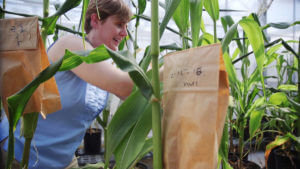The Bill and Melinda Gates Foundation is famous worldwide for using its $37 billion in assets to deliver vaccines, treat HIV, improve health for the world’s very poor, encourage sustainable farming and fund medical research.
But is the world’s largest private foundation backing away from certain advances involving genetic modification of food? Monica Schmidt, a plant scientist at the University of Arizona, has been studying the ability of “interference RNA” (RNAi) to switch off the production of aflatoxin, a persistent and hazardous toxin, in corn. Her work has shown a great deal of success—an earlier study showed RNAi shut down all corn aflatoxin—but the Gates Foundation turned down her proposal for a grant.
Why?
Because, Gates reviewers told Schmidt, it involved genetic modification, or GMOs. Her proposal to Gates, which had already given her work a $100,000 Grand Challenge grant, was rejected because it was disapproved by two reviewers, one saying, “It’s going to have public acceptance issues because it’s GMO,” Schmidt told the Arizona Daily Star in Tucson.
In a response to the Daily Star, the Foundation stated that only 10 to 12 percent of phase-one grants like Schmidt’s are awarded a second phase.
“While the University of Arizona work was not selected for phase two, the Foundation is funding other approaches to aflatoxin control,” the statement said in part. This statement did not address the opinions of the Gates reviewers who cited popular resistance to genetic engineering in food.
Schmidt’s work was not just another approach. Her study, published in Science Advances in March, showed that inserting a “cassette” of RNAi, which consisted of sections of the aflatoxin-expressing gene aflC, into the genome of kernels of (already) transgenic corn. The RNAi was specific enough so it only interfered with expression of aflC, and effectively shut down that expression so that aflatoxin was undetectable in all the corn samples Schmidt and her team tested. Just as important, transcripts (the RNA products of genes) in the RNAi-inserted corn were identical to non-inserted corn, indicating that no other genetic changes occurred:
Small interfering RNA molecules can be used to silence aflatoxin biosynthesis in maize, providing an attractive and precise engineering strategy that could also be extended to other crops to improve food security.

Bob Demers / UA News
Aflatoxin is an enormous threat to food security. They are known carcinogens, produced by several Aspergillus species, a type of mold. Ingestion of aflatoxin, can cause liver diseases (including cancer), kwashiorkor, Reye’s syndrome and impaired growth. About 16 billion tons of corn are lost worldwide annually, thanks to aflatoxin contamination. No current strategies to prevent aflatoxin infestation are successful. These include breeding disease-resistant plants, using trapping agents to block uptake, post-harvest storage changes, using atoxigenic Aspergillus and agricultural control to keep the fungus from growing.
The issue shows the swelling effect of anti-GMO activism, from NGOs, local governments and other organizations and individuals who have put up enough opposition to make even funders like Gates take second looks at projects—even promising ones like Schmidt’s—that involve GMOs. Gates has funded other organizations, like Cornell University’s Alliance for Science, that have themselves supported efforts using GMOs in agriculture and medicine. The Foundation also has funded research on the transgenic Golden Banana, engineered to express genes for enhanced iron and vitamin A production. The Foundation took a few hits from anti-engineering sites like The Ecologist for its stance, too. And in 2011, the Foundation announced grants to support work on cassava, and notably, the controversial transgenic Golden Rice.
Schmidt and her husband, in fact, took the long road to breed a soybean that originally (and more quickly) had been breed using transgenic techniques to avert soy allergies. That soybean is now being used to feed farmed salmon.
Other organizations also have had to respond to the “chill effect” against GMOs. In an interview with the Genetic Literacy Project, Arvind Kumar, head of the rainfed lowland South Asia plant breeding group at the International Rice Research Project in The Philippines, said that the IRRI looked at both genetic modifications and other, apparently less controversial breeding methods, when looking at improved rice strains. But the IRRI also has had to contend with governments influenced by anti-GMO pressure from groups like Greenpeace (GLP profile here) and individuals like activist Vandana Shiva, (GLP profile here) who have both worked (sometimes successfully) to prevent adoption of GM food in South and Southeast Asia:
We’ve never said no to transgenic projects. We don’t think there is just one method. We will support any method if we see the opportunity.
We have to follow rules and regulations of those countries, and work with those legal frameworks. We need more convincing arguments that in those cases that a transgenic is only viable solution.
Andrew Porterfield is a writer and editor, and has worked with numerous academic institutions, companies and non-profits in the life sciences. BIO. Follow him on Twitter @AMPorterfield.































